Domino’s Pizza Case Study: Strategic Management
Domino’s pizza case study analysis: introduction, case study domino’s pizza: competitive challenges, positive market outlook, international market expansion, growing health concerns, margin expansion, great innovation, robust brand name, poor advertising skills, competitive challenge, current strategies, digital platform, direct store ownership, conclusion of domino’s pizza case study, list of references.
Domino’s Pizza is a fast food chain of restaurants that is headquartered in the United States of America, but it has a large network of international branches worldwide (Abc News, 2013, para 5). The firm was established in 1960 by two brothers, Tom Monaghan and James Doyle, following the duo’s successive takeover of Dominicks. The business changed its trade name to Domino’s Pizza, Inc. five years later, in 1965, following a decision arrived by its sole owner Tom Monaghan at the time.
The firm’s first franchise store opened in 1967 in Ypsilanti. This reflected its growth. The first international store opened up in early 1983 in Canada’s Winnipeg area in the Manitoba province. The chain presently has a presence in close to 70 countries across the world. It employs a workforce of more than 145,000. It is considered to be the leading global fast-food chain of restaurants with corporate, as well as franchised stores that exceed the 10,000 marks (Domino’s, 2013, para 1).
Domino’s competes with other numerous fast food chains in the market that include both international and local market players. Domino’s is ranked second in the global market behind another American brand, Pizza Hut that is owned by YUM! Brands. Other established industry players include McDonald’s Corporation and Papa John’s International.
The rival firms have equally expanded their franchise networks and spread throughout the global market. The major competitive challenge has been maintaining lower operational costs in order to sustain higher profitability amidst the poor global economic situation. Consumers’ spending power was reduced significantly as many people considered spending their little disposable income on basic necessities only (Gluyas, 2013, para 2).

Domino’s Pizza Strategy Case Study: External Analysis
Consumer demands are also expected to increase with the overall global economy improving following poor performance in the recent past. According to Morning Star (2013, para. 6), restaurant industry sales in the US are expected to attain the $604 billion mark. This will represent a 3.6% annual growth.
This is critical, particularly coming immediately after a period of economic lull that lasted for about three years (Morning Star, 2013, para 7). The improving economic situation and conditions are enabling customers and potential buyers remain with a significant amount of disposable income that they can eventually spend on luxury products, such as buying and enjoying fast foods with their families and friends.
Domino’s eventual entry in 2010 into the German market has provided it with a great opportunity to enhance its profits and market performance in general.
A Master Franchise Agreement signed between the company and Yakir Gabay, the owner of over 3,000 residential units and a multiple number of hotels, offers a lucrative business opportunity for the restaurant chain. This has seen Domino’s grow to become the leading hotel operator in the entire German market. The growth is also attributed to Yakir’s extensive business network (Morning Star, 2013, para 3).
There has been growing concern among the consumers of fast foods that continued consumption of junk foods puts food users at greater risks health wise.
This situation could see quite a considerable number of potential customers lower their demand for the foods sold at Domino’s. In essence, the company will suffer losses as a result of diminished sales because its main focus is on pizza products (BizLeader, 2013, para 4).
The fast food industry is one of the leading industries globally in terms of high competition. The existing players are well established and pose a great market challenge to each other. New entrants are also flocking the industry (BizLeader, 2013, para 4).
All the players face the challenge of affecting their respective margin expansion as internationalization remains the obvious option to sustain the competition. The firms are spending huge capital amounts to sustain the expansion. This eventually puts the firms at the risk of failing to recoup substantial returns (PR Newswire, 2013, para 3).
Domino’s Pizza Analysis: Internal Factors
Domino’s Pizza is renowned for its ability to study its experiences and make corrective measures to enhance its future market performance. This has enabled the company to increase its innovation ability. This innovative approach led to a timely solution to the cold pizza delivery problem. The firm has also earned itself the tag of being a leading market trend setter. Domino’s main focus is on satisfying customers and achieving better customer experience (Pizza Marketplace.com, 2013, para. 4).
Domino’s Pizza is a strong brand name that is renowned for its pioneering pizza delivery business (PR Newswire, 2013, para 5). This, in turn, influences its power to retain and build loyal customers. It also enables the firm to constantly introduce new products.
For instance, the company has introduced several brands of its food products, including Domino’s Oven Baked Sandwiches, Domino’s BreadBowl Pats, as well as Chocolate Lave Crunch Cakes, among many others over a very short span of time (PR Newswire, 2013, para 6).
Given the goodwill that the brand has managed to build in the market, Domino’s can afford to introduce many products and still benefit from immediate customer acceptance. This reduces the possibility of encountering losses as a result of products taking too long in the market introduction and familiarization phase.
Domino’s committed a blunder in its marketing and advertising strategy when the company informed its consumers that it was able to deliver fresh and hot pizza irrespective of cold weather conditions. The villainous character, “The Noid”, was annoying and fictitious (Montgomery, 2013, para 3). It caused more confusion in the company’s marketing strategy, although it was short-lived.
The situation of the credit markets in the US has been of major concern in limiting Domino’s from achieving maximum market growth in the country. In close to ten years now, Domino’s has not been able to expand its operations in the US market through expanding its network of stores. As Buss (2013, p. 2) notes, only as little as 1,000 new stores are being planned for the US market by the company’s management.
This contrasts heavily with its external market plans that have so far lined up thousands of new stores for opening. The company is continuously reducing its number of stores in the US market. This affects its ability and power to compete in the world’s leading fast food market (Buss, 2013, p. 2).
With the US economy only having emerged from a financial crisis that spread all over the world, there are limited chances that the situation will normalize in the very near future in order to boost the company’s competitive power in the market. Thus, it implies that the single-unit operators within the American market are curtailed from opening up new branches to contain the challenge being posed by other rival firms, such as McDonalds.
It is worth noting that only 10 percent of Domino’s outlets in the US are company-owned, with the remaining 90 percent being franchised-owned (Buss, 2013, p. 1). It is a more challenging fact for Domino’s to fail to expand its market presence within this lucrative market, with the US market being by far the largest pizza market in the whole world (Buss, 2013, p. 1).
Domino’s is currently combining a series of strategies to formulate its major market strategy that has helped in enhancing its market operations and performance. With the advent of information technology, the firm has focused on developing a digital marketing technology that it has integrated with social media to increase interactivity with its mainly youthful clientele.
Additionally, the company is combining this with consistent pricing strategies for its menu as a means of sustaining its sales momentum that it has managed to enjoy for the last few years.
Domino’s has established a mobile-optimized website that is intended for use in making orders online. The firm has also pursued a plan that has eventually seen it introduce both Smartphone, as well as tablet apps intended for use in making orders (Marshall, 2013, para 6).
The Pizza Hero game software that was launched for iPad use underscores the great determination by the company to make use of digital capabilities in enhancing market performance. With the majority of fast food consumers mainly being youthful people, the company is relying on the group’s admiration for IT to attract them and eventually influence its market performance.
The popularity of social media websites, Facebook and Twitter, has also been inculcated into Domino’s market strategy as the company uses these platforms to increase its interactivity with customers. Potential customers are also attracted by the social marketing power upon reading sentiments and recommendations by the company’s long-standing customers. In other words, the company is utilizing the power of social media to reduce its advertising costs as the platform achieves the same results (Speedy, 2013, para 5).
Domino’s Pizza Case Study: Strategic Management Recommendations
Domino’s should consider involving itself directly in owning stores, especially within the lucrative American market. Waiting and hoping that the credit market situation in the country will stabilize in the near future to enable the franchisers the opportunity to borrow funds and expand their outlets is impractical.
Instead, Domino’s should invest part of its capital in opening up company-owned outlets to boost its overall presence in the market. This will give the firm a greater footing, similar to its main rivals.
In case running too many company-owned outlets poses a management challenge for the company, the organization can make arrangements with its individual market partners to hand them the shops. Such an arrangement would see the individual entrepreneurs run and manage the outlets as though they owned them personally, but submitting the resultant profits to the franchiser and receiving quotas from the same.
This will help in spearheading expansion in the market, while also empowering the franchise to grow their businesses. With Domino’s setting the quota-based system on the franchisee’s performance in the market, most of the franchisees will work hard to ensure that the businesses they manage grow bigger.
Domino’s Pizza is a leading global fast-food restaurant chain whose headquarters and foundations are based in the USA, but it has an enlarged network covering over 70 countries. The chain is currently considered as the second-best performing in the market after another American brand Pizza Hut. Domino’s greatest strength is in its innovation skills and capabilities that have seen it emerge as a market pioneer in many instances.
However, it’s advertising and marketing strategies have hampered its market performance following its promise to the market that it would manage to deliver hot and fresh pizza to its clientele during the cold season. Improving the global financial situation, especially after a long-term crisis, is proving to be of benefit to the company as it offers added opportunities for growth. Equally, the international expansion of the company is influencing its overall market performance by expanding the market and increasing sales volume.
The greatest market challenges for the firm are the failure of its US-based franchises to access credit and expand their business operations. This is affecting the overall business performance because the American market is by far the largest globally in as far as pizza sales are concerned.
Thus, any firm must take the American market seriously if it intends to compete effectively. As a remedy, the firm should invest directly in opening up branches in the country and invite franchisees to manage the branches on its behalf, instead of wasting time in waiting for the normalization of the domestic credit market.
Abc News, 2013, Domino’s Pizza® wants select startups, great ideas to be #PoweredByPizza , Web.
BizLeader, 2013, Domino’s Pizza® online ordering is faster than ever with launch of pizza profiles , Web.
Buss, D., 2013, ‘ Domino’s global growth feeds Pizza chain’s rising success ’, Forbes, Web.
Domino’s, 2013, About Pizza , Web.
Gluyas, R., 2013, ‘Meij delivers larger slice of Domino’s pie’, The Australian, Web.
Marshall, R., 2013, ‘ Domino’s Buderim CEO aiming high ‘, Sunshine Coast Daily , Web.
Montgomery, R., 2013, ‘Investors find Domino’s is topping out’, The Australian , Web.
Morning Star, 2013, Pittsburgh Domino’s Pizza franchise owner reaps national accolade , Web.
Pizza Marketplace.com, 2013, Domino’s new store design hits New Orleans market , Web.
PR Newswire, 2013, New Orleans Domino’s Pizza opens first new store design in the West Bank Area , Web.
Speedy, B., 2013, ‘Domino’s lifts profit, eyes expansion into Japan’, The Austrian , Web.
- Chicago (A-D)
- Chicago (N-B)
IvyPanda. (2023, August 24). Domino's Pizza Case Study: Strategic Management. https://ivypanda.com/essays/dominos-pizza-company-analysis/
"Domino's Pizza Case Study: Strategic Management." IvyPanda , 24 Aug. 2023, ivypanda.com/essays/dominos-pizza-company-analysis/.
IvyPanda . (2023) 'Domino's Pizza Case Study: Strategic Management'. 24 August.
IvyPanda . 2023. "Domino's Pizza Case Study: Strategic Management." August 24, 2023. https://ivypanda.com/essays/dominos-pizza-company-analysis/.
1. IvyPanda . "Domino's Pizza Case Study: Strategic Management." August 24, 2023. https://ivypanda.com/essays/dominos-pizza-company-analysis/.
Bibliography
IvyPanda . "Domino's Pizza Case Study: Strategic Management." August 24, 2023. https://ivypanda.com/essays/dominos-pizza-company-analysis/.
- Domino’s Pizza Inc.’s Strategy of Innovation and Technology
- Domino's Pizza Crisis Communication
- The Domino’s Pizza Company’s Competitive Advantages
- Consumer Behavior in the Context of Restaurant Domino Pizza
- Dominos Pizza in Canada and Mexico
- The Domino’s Pizza Company’s Financial Analysis
- Domino’s Pizza: Social Media Case
- Corporate Finance of Domino's Pizza Enterprises
- Domino’s Pizza’s Entry into the Estonian Market
- Domino Pizza Entry Strategy
- Roll Rite, LLC: Selecting the Best Markets for the Export
- McDonalds Globalization in America
- Kantar Media Company Performance
- The Reasons of Yahoo’s Success
- U.S. Marine Corps Culture and Values
- SUGGESTED TOPICS
- The Magazine
- Newsletters
- Managing Yourself
- Managing Teams
- Work-life Balance
- The Big Idea
- Data & Visuals
- Reading Lists
- Case Selections
- HBR Learning
- Topic Feeds
- Account Settings
- Email Preferences
How Domino’s Pizza Reinvented Itself
- Bill Taylor

And moved its share price from $8.76 to over $160.
I spent the last 18 months researching and writing a book on how organizations and leaders can do extraordinary things, even if they operate in pretty ordinary fields. You don’t have to be a programmer in Silicon Valley or a gene splicer in biotech to unleash exciting innovations and create huge value. Instead, you can rethink what it means to be in the retail-banking business, or the industrial-distribution business, or the office-cleaning business. Yet little did I know that some of the most extraordinary innovations I’ve seen would take place in the pizza business.
- Bill Taylor is the cofounder of Fast Company and the author, most recently, of Simply Brilliant: How Great Organizations Do Ordinary Things in Extraordinary Ways . Learn more at williamctaylor.com.
Partner Center
Domino's Marketing Strategy: How it is Dominating the Pizza Delivery Industry
Learn about domino's iconic marketing strategy and advertising campaigns. read how domino's aces the 4ps of marketing mix - product, price, promotion & placement..
- overview#goto" data-overview-topic-param="a-slice-of-domino-s-history">A Slice of Domino's History
- overview#goto" data-overview-topic-param="target-audience">Target Audience
- overview#goto" data-overview-topic-param="marketing-mix">Marketing Mix
- overview#goto" data-overview-topic-param="domino-s-marketing-strategies">Domino's Marketing Strategies
- overview#goto" data-overview-topic-param="domino-s-marketing-masterpiece">Domino's Marketing Masterpiece
- overview#goto" data-overview-topic-param="maximize-your-marketing-potential">Maximize Your Marketing Potential

Domino's is a mainstay of the global food delivery industry thanks to its delectable pizzas and lightning-fast delivery. With a core customer base predominantly from the US, followed by India and Malaysia, Domino's 2021 revenue reached 4.36 billion USD.
Behind the brand's phenomenal success is a well-thought-out marketing strategy that has set the company apart from its top competitors (Papa John's and Pizza Hut) and propelled it to the top of the industry making it the largest pizza chain in the world.
In the following article, we will delve into the key components of Domino's marketing strategy, exploring the creative marketing strategies that have allowed the company to thrive in a highly competitive landscape.
A Slice of Domino's History
In 1960, Tom and James Monaghan started Domino's in Ypsilanti, Michigan with a goal to revolutionize the pizza industry by delivering hot pizzas to customers' doors. Little did they know their small venture would become a worldwide success.
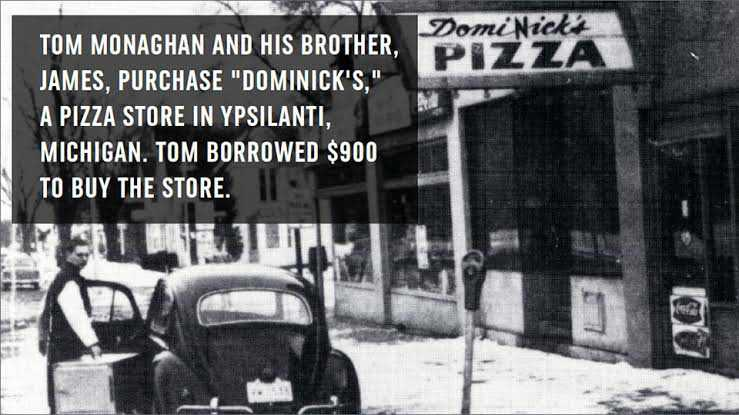
Source: Domino's
As the years passed, Domino's widened its scope and expanded into new markets. By the end of the 1970s, there were 200 stores nationwide, and by the turn of the century, the brand had firmly established itself on the international stage.
In the 2000s, the company underwent a modernization drive that resulted in the introduction of new menu selections as well as the creation of a cutting-edge website and mobile application that made ordering Domino's pizza easier and more convenient than before.
Today, with over 17,000 stores in over 90 countries, Domino's stands tall as one of the largest pizza chains in the world. With a steadfast commitment to quality and convenience, the brand continues to provide customers with the opportunity to enjoy their favorite dominos pizza and accompaniments.
The Dominos logo, which is a stylized representation of a domino tile with three dots, is more than just a decorative element.
The three dots in the company logo represent the first three Domino's locations in Ypsilanti, Michigan, and serve as a reminder of the company's origins. Pizza lovers all over the world may recognize the company name and emblem because of the vibrant blue letters and white background that they create.
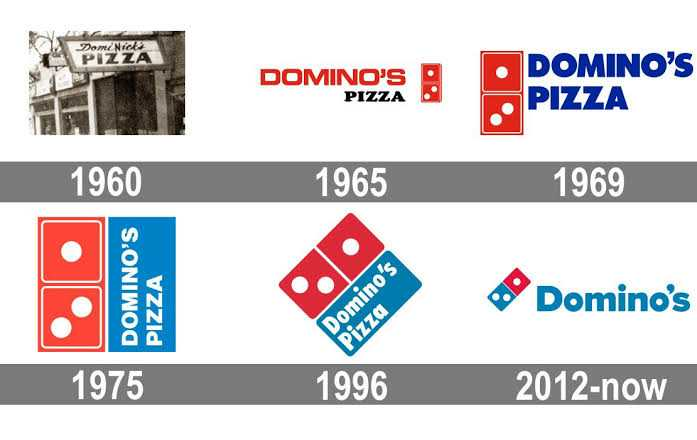
Source: 1000 Logos
Target Audience
Domino's Pizza caters to diverse age groups including families, young adults, and busy professionals looking for a quick, convenient, and affordable meal. The focus of the fast food chain on delivery and technology appeals to people who value convenience and speed.
Furthermore, the company's menu caters to both meat eaters and vegetarians, with veg pizza and non-veg pizza which helps to attract a broader range of customers through franchise owners.
Marketing Mix
Domino's success is largely due to its well-planned marketing mix, resulting from thorough market analysis. Let's examine how the four Ps of Dominos marketing strategy contribute to its success.
Product Mix
The well-known pizza restaurant Domino's provides a wide range of menu options to accommodate the diverse tastes of its patrons including veg pizza and non-veg pizza. Dominos Pizzas, which are their specialty, are available in classic flavors which can be topped with different toppings.

Source: Domino's India
In addition to their well-known breadsticks, pizza burger, and salads, they provide a wide range of sides to go with their veg and non-veg pizzas. Domino's offers a selection of drinks, such as lemonade and soft drinks, as well as delectable desserts to satisfy its customers' desires for sweets.
Domino's masterful pricing strategy offers a tantalizing blend of affordability and excellence. Pizzas, the cornerstone of their menu, start at $5 for a medium size with toppings options. Accompaniments like breadsticks and salads begin at $3, while delectable desserts can be yours for as little as $2.
To further enhance the value proposition for its customers, Domino's routinely offers enticing specials and combo packages, allowing customers to try a range of menu items at a lower price. This pricing marketing strategy of Dominos helps it attract customers of all budgets.
Distribution
In 1967, Domino's opened its first franchise, laying the framework for the company's expansion into international markets. Today, the company operates more than 19500 locations worldwide, including 6619 in the US and 1,567 in India under Jubilant Food Works.
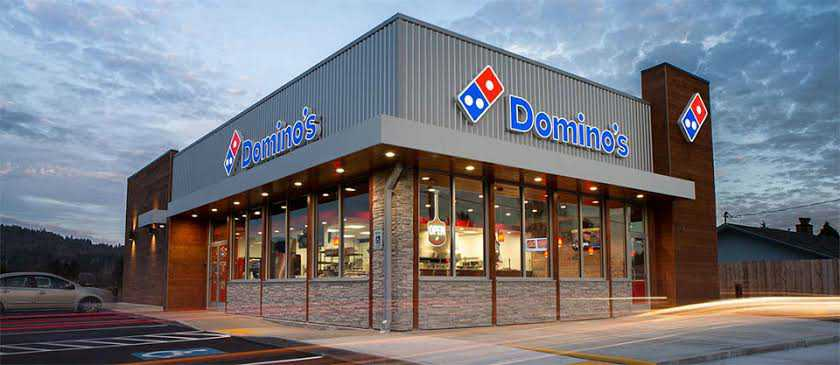
Company-Owned Stores
At the forefront of Domino's Distribution strategy are its company-owned stores, which offer customers a wide range of options for enjoying its menu offerings. Dine-in, carry-out, or delivery, the choice is theirs.
Using a vertically integrated supply chain, the company has established itself as a top-tier pizza supplier and is better able to compete in the market by successfully coordinating its resources and controlling the cost structure.
Franchise Stores
In addition to company-owned stores, Domino's also operates a large number of franchise stores. Domino's focus on a franchisee-owned business model and low-cost infrastructure investment aims at serving amazing food fast to people on move. This marketing strategy has helped Dominos to enter new markets while still being major cost component making it viable in developing nations where there is low capita income.
E-commerce Platform and Delivery Services
For those who prefer the comfort of their own homes, Domino's offers a user-friendly online ordering platform that can be accessed through a website or their own app, providing customers the ability to place orders whenever they want, from anywhere.
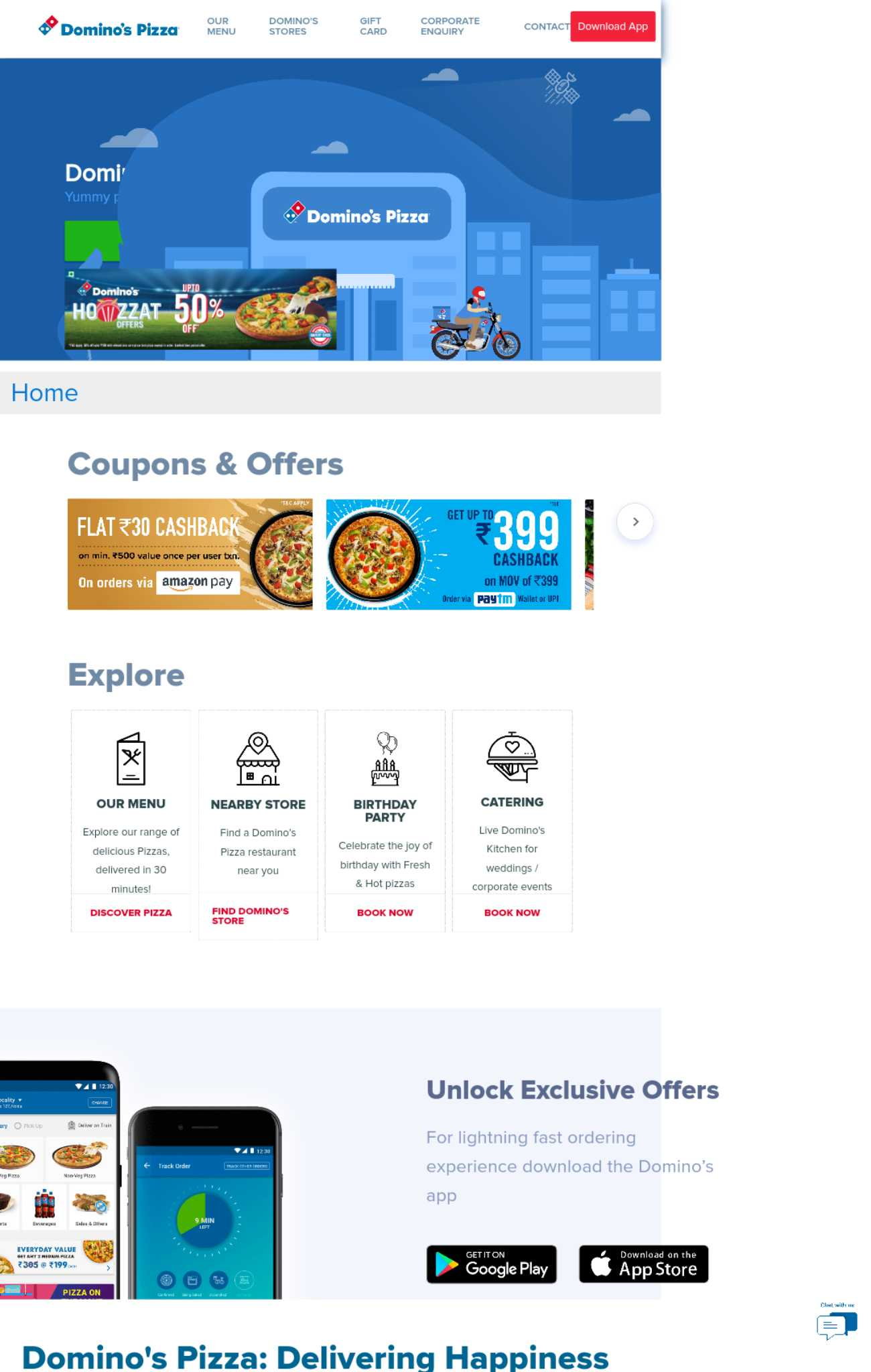
Domino's leverages technology for fast and efficient delivery, with real-time updates and GPS tracking. In 2014, they introduced Carside Delivery in the US.
Global Presence
Additionally, Domino's has a substantial international footprint. With the US as its main market, it operates in more than 90 countries allowing clients to relish its products anywhere in the world.
In several of its international regions and developing nations, Domino's has embraced a localization approach and offers menu items that are tailored to regional tastes and preferences. To cater to Indian pizza lovers Dominos replaced pepperoni beef-based topping with spicy chicken sausage topping.
The business's digital ordering system enables several payment methods and is available in multiple languages, making it simple for customers to place purchases.
Partnerships
By forming smart alliances directly with foreign delivery businesses, Domino's has been able to reach a wider clientele. Domino's partnerships include Lipton, Mountain Dew, 7Up, ITC, PepsiCo, etc.
Promotion Mix
Domino's stands out with innovative advertising and promotions, interacting with customers and staying ahead of trends. Let's examine their use of the elements of the promotion marketing mix and some of their top digital marketing strategies:
Advertising
Domino's advertising strikes a balance between consistency and impact, evoking a sense of togetherness. Their "Oh Yes We Did" campaign showcased new menu items like pizza recipe, desserts, and sides, while the "You Got 30 Minutes" commercial guaranteed 30-minute delivery or the pizza was free.
Domino's also uses billboard ads, such as the 2011 real-time consumer feedback billboard in Times Square, showing positive, neutral, and negative comments..
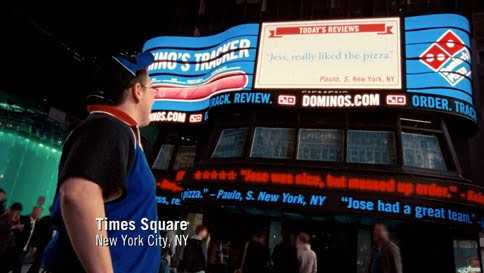
Source: Food Channel
Social media Marketing Strategy
Domino's uses the social media platforms Facebook, Instagram, and Twitter to keep their customers informed about sales and new goods. KFC posts pictures of their meals on social media and engage with the public by using popular hashtags.
Sales Promotion
To attract customers Domino's offers a wide range of momentary discounts and specials. Additionally, they offer extra promotions throughout specific times and events.
Public Relations
Domino's uses PR strategies like "Dominos Cares" and "Domino's Carside Delivery," which offer contactless delivery options, to build strong relationships with customers and enhance brand perception .
Email Marketing and SMS Marketing Strategy
To reach customers and foster brand loyalty, Domino's uses targeted internet advertisements and direct marketing methods like email marketing, SMS Marketing, and direct mail with a call-to-action buttons. They use consumer data to provide customers with personalized offers based on their past purchases.
Domino's partners with sports leagues, music festivals, and events to attract customers and raise brand awareness. In 2001, they teamed up with the Make-A-Wish Foundation for a two-year partnership. They also collaborated with the Spanish esports organization Liga De Videojuegos Profesional (LVP).
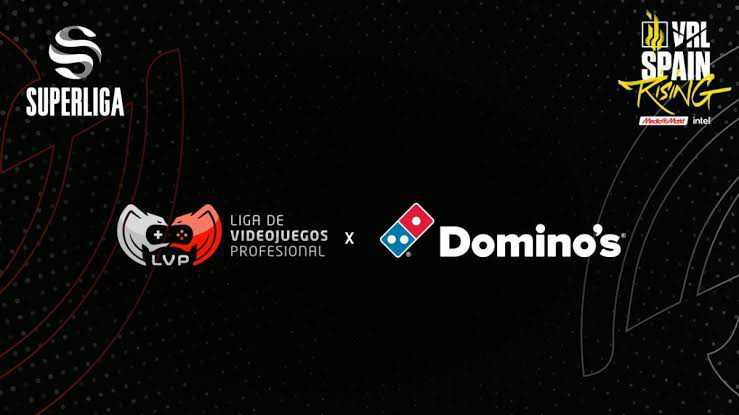
Source: LVP
Domino was RCB's official partner for the entire IPL season in 2018.
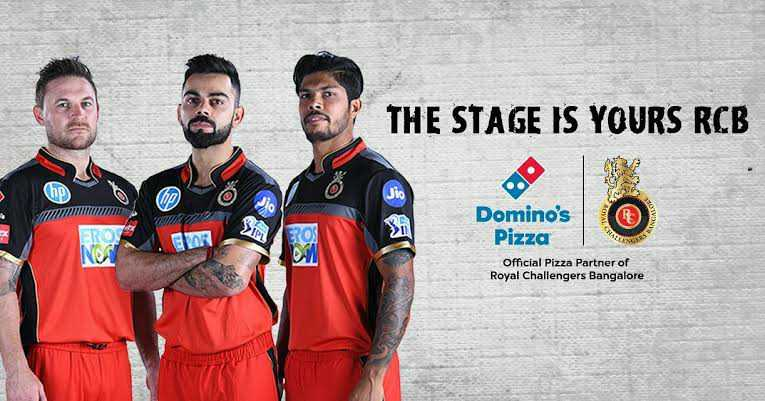
Source: Facebook
SEO and Search Engine marketing
To boost its brand's presence on search engines, Dominos pizza uses both organic and paid searches. Domino's paid search includes Google ads, sponsored Facebook ads, and YouTube advertisements to target their audience based on their location and age group.
In the restaurant sector, according to Semrush traffic figures for December 2022, Dominos.com came in third with 54 million visitors, an average session time of 10:51, and a bounce rate of 31.64%.
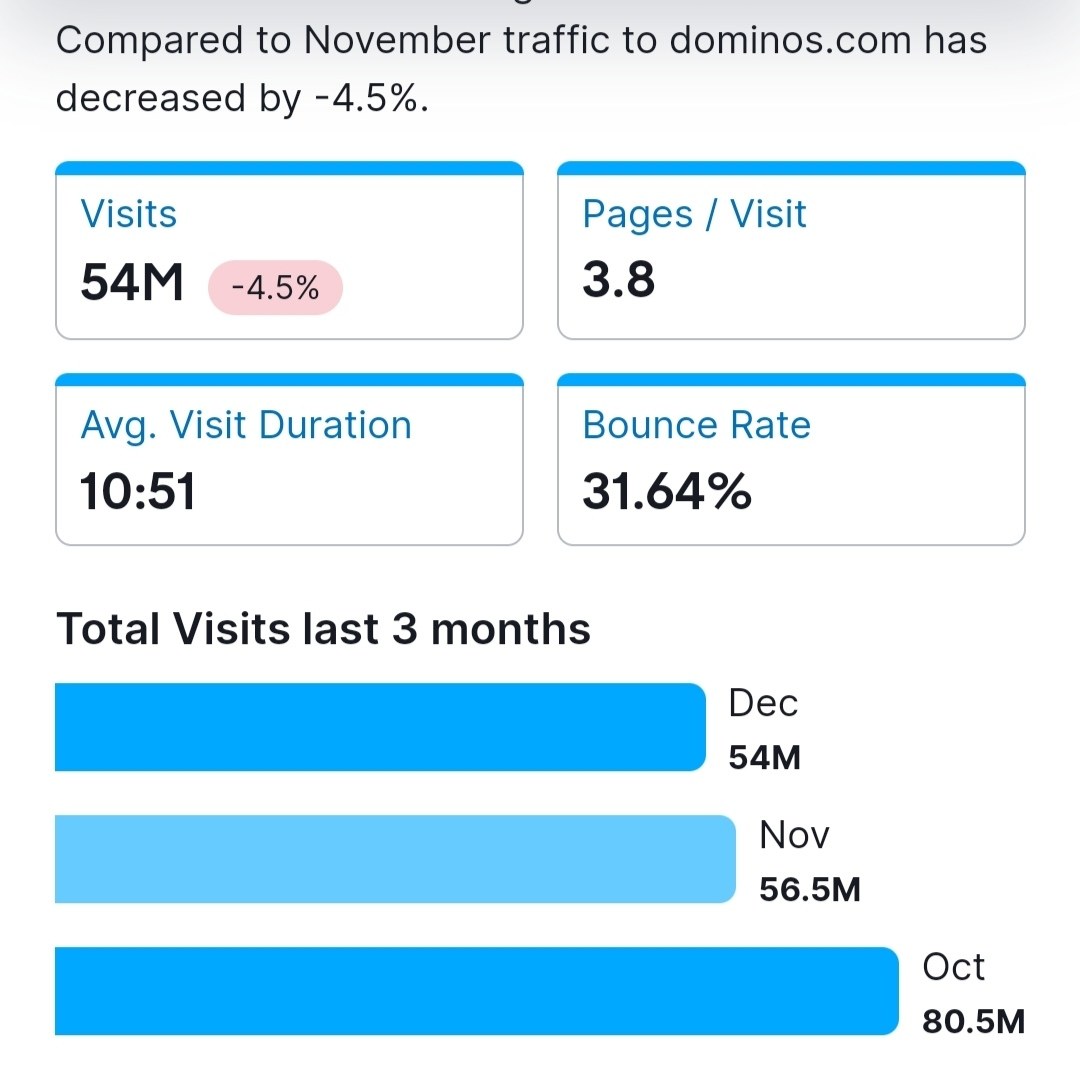
Source: Semrush
17% of visitors to Domino.com use a desktop computer, while 80% use a mobile device. There were 25.7 million organic visits and 1 million paid visits to the Domino website in December.
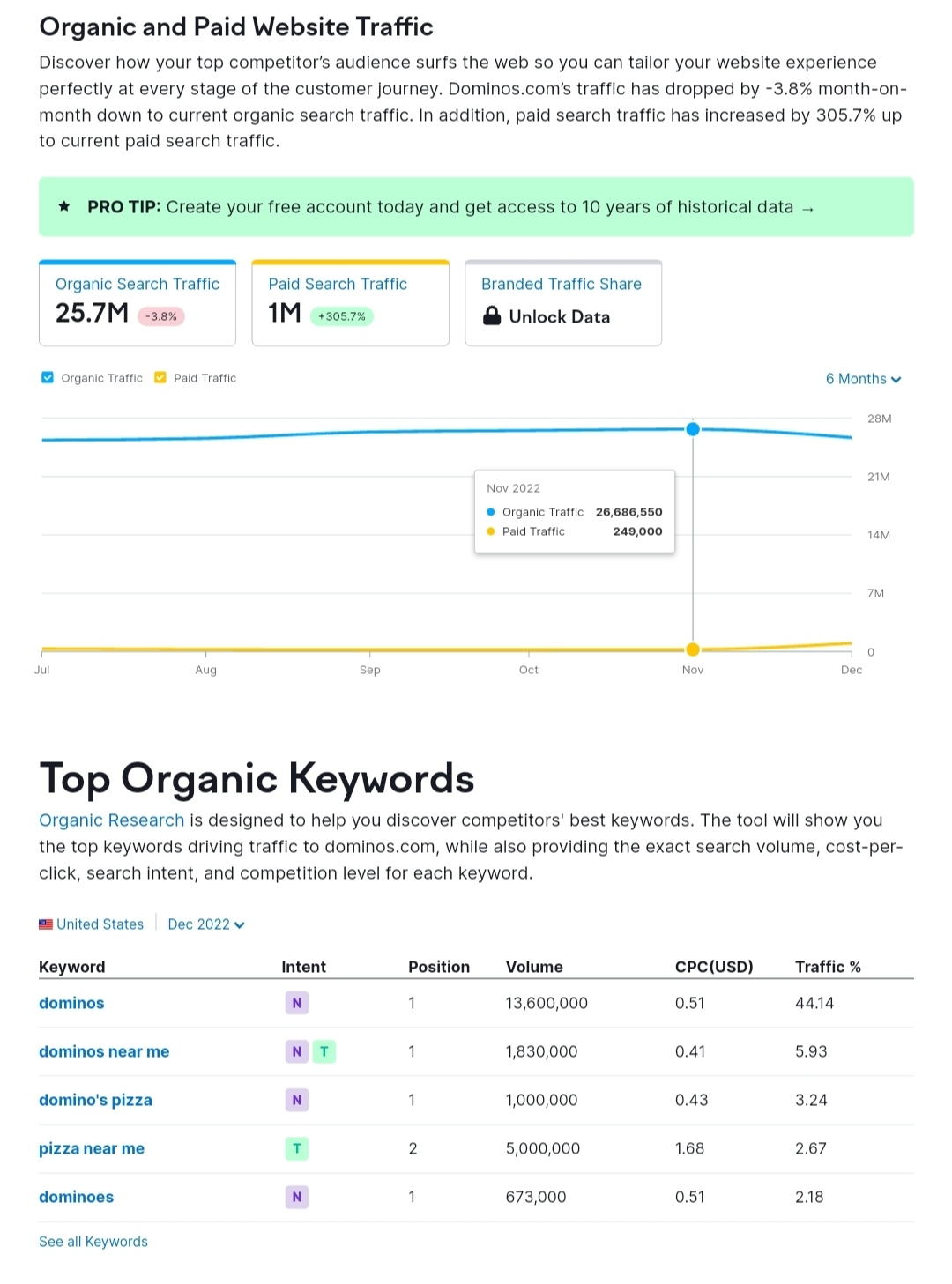
Domino's Marketing Strategies that Made a Difference
With a history of game-changing campaigns, and creative adverts, Domino's has risen to become one of the world's largest pizza chains. Let's take a closer look at other best marketing strategies that have made a difference, and put Domino's on the map as a global brand.
Digital Platforms
Domino's has taken the lead in using technology to enhance customer satisfaction by embracing digitalization. Customers can easily and quickly place orders with the use of the company's mobile apps, delivery tracking, and ordering online capabilities.
Domino's Pizza has integrated cutting-edge technology into their ordering system with the introduction of their "Domino's Voice Search" feature. This allows customers to effortlessly place their pizza orders via voice commands through the use of either the Domino's mobile application or Amazon Alexa/Google Assistant enabled devices.
Client-Centered Methodology
Client satisfaction forms the most of the Dominos marketing strategy. As Domino's has always prioritized its customers' needs and wishes and placed a high priority on doing so. The company continuously solicits customer feedback and uses it to improve both its services and the overall customer experience .
Value Proposition
Domino's has developed a strong value proposition based on its track record for timely and reliable delivery. The company's motto, "You Got 30 Minutes," has come to signify that hot, fresh pizza will be delivered within 30 minutes of receiving an order. This plays a main role in Domino's having a high market share compared to other pizza outlets like Pizza Hut, and Papa John's.
Diverse Menus
For its customers' benefit, Domino's appeals its customer base with Dominos veg menu and non-veg menu and it frequently introduces brand-new menu items and technological innovations. This has helped Dominos to keep the brand fresh and relevant while bringing in new customers.
AI-based chatbots
An excellent illustration of Domino's dedication to innovation is the use of AI-powered chatbots for customer service. These chatbots are available 24/7 and can handle a variety of consumer inquiries, providing prompt and efficient replies.
Design for an immersive pizza theatre
For its locations, Domino's has adopted an innovative "Pizza Theater" design that incorporates technology and interactive components to provide customers a fully immersive experience. This design strategy sets Domino's unique and exemplifies the company's dedication to innovation and technology, from digital menu boards to open kitchens.
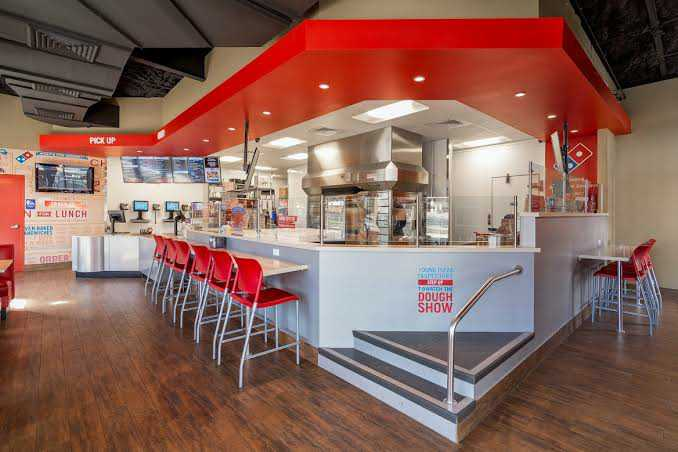
Source: Crain's Detroit
Domino's Marketing Masterpiece: A Look at its Game-Changing Ad Campaigns
Ad campaigns are the heart and soul of any marketing strategy, and Domino's has been delivering on this front for decades. From its iconic "30 minutes or less" promise to its more recent forays into digital marketing, Domino's has consistently raised the bar for pizza chains around the world.
With a focus on creative storytelling, customer engagement, and memorable slogans, Domino's ad campaigns have played a crucial role in shaping the brand's image and driving sales. Let's look at some of Domino's most memorable and game-changing ad campaigns:
Domino's Fashion Week Debut
In the midst of the bustling festivities during London Fashion Week of 2019, one unlikely brand made its mark on the fashion world - Domino's. With a unique collaboration with designer Liam Hodges, the pizza chain crafted a comfort-driven collection, dubbed "Night In," inspired by the growing trend of staying in rather than going out.
The collection, consisting of the "Controller Coat," a stylish cape with pockets for holding essentials like tv remote, and gaming controller; the "Gaming Bag," a cozy sleeping bag suit; and the "Boxset Blanket," a three-person blanket for TV bingeing, was designed to elevate "nights in" to be more memorable. The campaign generated buzz on social media, amplified by a competition that offered users the chance to win one of the three highly coveted designs.

Source: Fads magazine
The Last Slice
In 2022, as the globe celebrated International Friendship Day, Domino's India began a moving social experiment to show the impact of just one slice of pizza. Schbang, who conceptualized and carried out the #Thelastslice campaign, brought complete strangers together for a humorous experiment that fostered new friendships.

Source: Schbang
Three pairs, consisting of creators and influencers, were given only the last slice of a pizza and with each bite, conversations started flowing and bonds were formed. The last piece served as the ideal icebreaker, showing us all that even the tiniest things can draw people together. A new bond was formed as the last bite was taken.
Who says you need an entire pizza to have a meaningful connection?
Domino's Puts Local Marketing on the Map
As a global giant, Domino's knows the importance of forging a personal connection with consumers on a local level. In 2018, the brand set out to tackle a common pain point for drivers and pizza lovers alike - potholes. With its ' Paving for Pizza ' campaign, Domino's invited customers to nominate their town for a paving grant, ensuring their pizzas would make it home in one piece.
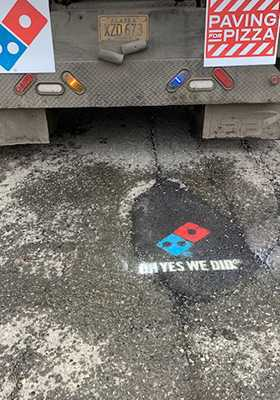
Source: Paving For Pizza
This lighthearted take on a serious subject not only generated discussion and interaction on social media, but it also showed Domino's dedication to having a positive effect on neighborhood communities.
The campaign garnered an astounding 35,000 organic mentions on social media in just its first week. Domino's increased the budget after seeing how well it worked to cover all 50 states , demonstrating that even the most powerful businesses can create meaningful change, one pothole at a time.
Tweets for Treats
In March 2012, Domino's UK introduced the "Tweets For Treats" Twitter promotion to boost lunchtime orders. By offering a discount for each tweet that included the hashtag #letsdolunch, they amassed 825 tweets and reduced the price of the Pepperoni Passion pizza from £15.99 to £7.74.
With 13% of digital purchases made on mobile devices, the campaign increased online pizza sales by 43% and overall revenues by 14.6% to £43.6 million . It was a successful marketing strategy of Dominos that raised brand awareness and gained more fans and followers.

Source: Skipedia
Maximize Your Marketing Potential with Lessons from Dominos Marketing strategy
Marketing strategies can often be dry and uninspiring, but Domino's innovative approach to the industry serves as a lesson in creativity and customer-centricity. Here are six key takeaways from marketing strategy of Dominos that marketers can learn:
Convenience is King
Domino's places a strong focus on the importance of simplifying customers' lives through a steadfast commitment to delivery and user-friendly digital ordering.
Inventive Methods
The customer experience is improved by Domino by integrating technology into its daily operations, such as AI-powered chatbots and GPS tracking. This also increases operational transparency.
Putting customers first
By prioritizing client feedback, Domino's illustrates how a customer-centric marketing strategy is necessary for success in any industry.
A Strong Brand Identity
Domino's has expertly crafted their brand to stand out in consumers' minds, in such a way that elements such as their iconic logo and memorable jingles contribute to their distinctive image.
Global Growth with Regional Accents
Domino's exemplifies the importance of maintaining a strong brand identity when entering new markets by adjusting to regional tastes and cultural norms.
Unwavering Concentration on Quality
With a vertically integrated supply chain Domino maintains its position as a market leader in the pizza sector by consistently enhancing the flavor of their goods, demonstrating that quality should always come first.
The success of Domino's in the intensely competitive fast-food industry has been significantly attributed to the marketing strategy of Dominos. By conducting a thorough market analysis, Domino's has been able to secure a significant market share, outpacing its competitors like Pizza Hut, and drive sustainable growth through innovative and data-driven marketing strategies. How Domino's retains innovation and its competitive edge with its marketing strategy as the food market matures will be an intriguing thing to watch.
If Domino's Case Study intrigued you check out McDonald's marketing strategy for further details on the fast food industry.
- popover#mouseOver mouseout->popover#mouseOut" data-popover-translate-x="-25%" , data-popover-translate-y="-220%"> Copy link
- bottom-bar#toggleTagsSection"> popover#mouseOver mouseout->popover#mouseOut" data-popover-translate-x="-25%" , data-popover-translate-y="-220%"> Copy Link
- bottom-bar#toggleTagsSection">

"Must read for every entrepreneur"

"The best part is it's written by real entrepreneurs"

"My favorite newsletter on the web"
You'll love these articles too!

Co-founder & CEO at Flexiple ($3mn+ revenue, bootstrapped) & buildd.co | Helping Startup...
Customer Experience Analytics (CX Analytics) - a Detailed Guide
If you are wondering what customer experience analytics is and how can one quantify customer experience to devise strategies, then keep reading this article.

Co-founder at Flexiple, buildd & Remote Tools ($3 million revenue, bootstrapped)

How to use a Brand Platform for building your brand identity?
Understand why to build a brand platform for your business and how you can execute the necessary brand platform strategies using the brand identity.

Logo Designs Hub: Your digital journey begins here in the USA and Germany. We specialize in...

Digital Folks is an award-winning website designing and Lead generation company in Canada. Our...

There's an air of mystery about 😮. They haven't filled their profile yet.

There's an air of mystery about Vinit 😮. They haven't filled their profile yet.

The Nykaa Marketing Strategy: Catalyzing it to a leading beauty eCommerce giant
Learn about Nykaa's iconic marketing strategy and advertising campaigns. Read how Nykaa aces the 4Ps of marketing mix - Product, Price, Promotion & Placement.
More From Forbes
How data creates trillion dollar firms: the case of domino’s pizza.
- Share to Facebook
- Share to Twitter
- Share to Linkedin
Domino's Pizza
In conventional terms, Domino’s Pizza is a winner. Its CEO, Rich Allison, was on CNBC’s Mad Money yesterday , touting Domino’s strong post-pandemic financial performance, its almost-2000% growth in market capitalization over 10 years, and its successful digital transformation. Domino’s has defeated its long-time rival, Papa John’s , to become the dominant pizza shop, world-wide. Its stock has outperformed even Apple and Amazon over 7 years . But in the digital age, the challenge for Domino’s to become a lasting success has only just begun.
I learned why in my conversation with business analyst Ray Wang, author of the illuminating new book, Everybody Wants to Rule the World (HarperCollins, July 2021). Wang explained that in the digital age, Domino’s real long-term competitor isn’t Papa John’s: it’s Door Dash , which already has a market capitalization three times that of Domino’s, as shown in Figure 1. Wang predicts that by 2050, the global marketplace will comprise around 50 giant duopolies. In each market, there will be only two dominant digital giants. 90% of the current Fortune 500 will have disappeared. Domino’s chance of being one of the long-term winners will depend on data more than pizza.
Figure 1: Market cap: DoorDash, Domino's Pizza, and Papa Johns
The Case Of Domino’s Pizza
Steve Denning : Can you tell me why Domino’s long-term future depends on data more than pizza?
Ray Wang : It’s scary. Domino's Pizza is the poster child for digital transformation. You can order pizza any way you like. You can order on Alexa. Their back-end logistics and capabilities are amazing. Automation and artificial intelligence (A.I.) are there. If you order pizza on a Friday at five p.m., Domino’s knows, two weeks later, to remind you that, maybe you want to order a pizza?
Who Is The New Platinum Card From American Express Good For?
What to do if you still haven't received your child tax credit payment.
So you ordered a pizza. Great! Domino’s tracks the pizza from the time it's ordered. It goes to the oven. It sends you a message: it's five minutes away! It's one minute away! Are you ready to eat? And you've already paid for it online. You can take a picture of the pizza, run it through an A.I. bar and it will tell you the quality of the franchisee. It’s amazing. They are one of the few firms to have won the battle of digital transformation.
Steve : So what’s the problem?
Ray : Think of how often people order from food delivery apps, not just Domino’s. You might want Thai food delivered from your favorite local restaurant. Or Italian, or maybe some Polish specialty? Or something German? Maybe French? It’s all being delivered. The long-term winner will be the firm that can offer all of those specialties, not just one.
And in the middle of the pandemic, the food delivery apps like DoorDash , began taking the essential steps to become the dominant digital giant in the food sector, particularly, dis-intermediated customer account control. Small businesses gave their customer data willingly to these food delivery apps, saying, “Take our customers: just order from here!” And then these delivery app companies took the payment information. They started tracking the data. They could understand from your zip code whether you are in high end or downscale area. And they started to understand the data. And over time, instead of working with hundreds or even thousands of customers that a small restaurateur work might have, they start to have millions of customers. And so they dis-intermediated customer account control. They were competing for data supremacy. They built the largest network they could. They basically took customers from the small businesses. They were competing on data. They use that information to improve their products, improve their offerings.
Now they are able to go on to do digital monetization through ads, search products, services, memberships and subscriptions. They can think long-term to win in these markets.
And the challenge for a firm like Domino's from here on is hard. Because what do they do? Do they go head on with these delivery apps and offer more products? That will be tough because the categories are already taken and Domino’s doesn’t have culinary expertise in all those categories.
So if I was advising Domino's, I'd suggest offering, “Delivered by Domino's!” and allow small businesses around the country to use Domino’s digital infrastructure and its digital technology to join with Domino’s in creating a separate joint venture startup, in which they could participate and help local businesses succeed and create partnerships with payment organizations and improve that capability along the way.
We'll see if they have vision the the willpower, and talent, and the courage to persuade their board and their shareholders to think of Domino’s in the long term as a potential digital giant.
Creating A Data-Driven Digital Network
Steve: And so they would need to launch a digital data network—in effect, a food delivery ecosystem ?
Ray : Yes, it would be a data driven digital network, Domino’s already has the platform. Now they can license that to other restaurants.
Steve: What does that involve?
Ray : To accomplish this kind of transformation, a firm has to start changing the mindset of the organization, including the following steps:
· It’s about changing the life cycle of the organization and finding a catalyst, a turnaround catalyst; sometimes an owner-operator or more investment comes in.
· They have to attract the right talent.
· It means taking advantage of a new technology to change how the offerings are being delivered.
· It may mean changing markets. Instead of thinking about geographic markets or verticals, a firm might have to think about where its data value chains are and how they play a role and how they want to capture that upstream and downstream data in that value chain
· It may mean invigorating or removing shareholders that don't understand what a long-term mindset looks like. It may also need some board education,
· It means building partnerships and ecosystems that can compete with the Agile giants who are investing ten times what a firm is doing with capital expenditures. Some companies are in the process of making that shift.
Steve : Are C-suites up to the challenge?
Ray : Even if they are, boards are often not. And that's where a lot of the challenge is occurring.
Steve : Why is that?
Ray : Boards often don't want to rock the boat. The average independent board member sits on three or four boards. Their their mission to make sure that shareholders get what they want. But the main challenge isn't in the independent board directors. It's really in the 40-50% of companies that have a similar ownership structure, whether it's investor groups or pension funds or sovereign wealth funds. Those groups have a lot more influence than people realize. It’s a concentration of control.
And read also:
Why The Entire Economy Will Be Run By Digital Giants
Why Ecosystem Firms Are The Future Of Management

- Editorial Standards
- Reprints & Permissions

Domino’s SWOT Analysis

Before we dive deep into the SWOT analysis, let’s get the business overview of Domino’s. Domino’s Pizza, Inc. is an American multinational pizza restaurant chain founded in 1960. The company is headquartered in Ann Arbor, Michigan, USA, and operates in over 90 countries worldwide.
Domino’s is known for its focus on delivery and carryout pizza service, with more than 18,000 locations globally. The company offers a variety of pizzas, sides, and beverages to its customers, including its famous hand-tossed pizzas, thin-crust pizzas, and Brooklyn-style pizzas.
In addition to its traditional pizza offerings, Domino’s has introduced innovative products, such as the “Pizza Tracker” and the “Domino’s Anywhere” mobile app, which allow customers to track their orders in real-time and place orders from anywhere, respectively.
Domino’s is also committed to sustainability and social responsibility, with initiatives such as using electric and hybrid vehicles for delivery, reducing packaging waste, and supporting local communities.
Domino’s ranked fifth in the world’s leading quick-service restaurants in terms of revenue in 2021, with a brand value of over 12.4 billion U.S. dollars. Overall, Domino’s has established itself as a leading player in the pizza industry, with a strong focus on innovation, technology, and customer satisfaction.
Domino’s is not a pizza delivery company. What it is, then?
Here is the SWOT analysis for Domino’s
A SWOT analysis is a strategic planning tool used to evaluate the Strengths, Weaknesses, Opportunities, and Threats of a business, project, or individual. It involves identifying the internal and external factors that can affect a venture’s success or failure and analyzing them to develop a strategic plan. In this article, we do a SWOT Analysis of Domino’s.
SWOT Analysis: Meaning, Importance, and Examples
- Strong brand recognition : Domino’s is a well-known brand with a strong reputation in the pizza industry. The company has invested heavily in advertising and marketing campaigns, which have helped to establish its brand identity and attract new customers.
- Focus on delivery and carryout : Domino’s has focused on delivery and carryout services, which has allowed the company to differentiate itself from its competitors. The company’s efficient delivery service has made it a convenient option for customers who want to enjoy pizza at home.
- Innovation : Domino’s has introduced new products, services, and technologies to enhance the customer experience. The company’s Pizza Tracker and Anywhere mobile app are examples of its commitment to innovation.
- Global presence: With more than 18,000 locations worldwide, Domino’s has established a significant international presence, allowing it to tap into different markets and diversify its revenue streams.
- Franchise model : Domino’s operates a successful franchise model, which has allowed the company to expand rapidly while keeping costs low. This has also permitted franchisees to benefit from the company’s strong brand and operational expertise.
- Efficient supply chain : Domino’s has established an efficient supply chain that enables the company to deliver fresh pizzas quickly to customers. The company’s focus on technology and innovation has helped it to optimize its supply chain, resulting in cost savings and increased efficiency.
- Excellent Customer Service : Domino’s ranked above the average limited-service restaurant’s American Customer Satisfaction Index (ACSI) score of 80 in 2021. Meanwhile, competitors Pizza Hut and Papa John’s received a lower customer satisfaction score during this period.
These strengths have helped Domino’s maintain its position as a leading player in the pizza industry and drive its continued growth and success.
- Dependence on franchisees : While the franchise model has allowed Domino’s to expand rapidly, it also means that the company is dependent on the performance of its franchisees. Poorly performing franchisees can hurt the company’s reputation and financial performance.
- Limited menu options : Domino’s menu is primarily focused on pizzas, and while the company has introduced new items like pasta, sandwiches, and desserts, it still has a relatively limited menu compared to some competitors. This could limit the company’s appeal to customers who want a wider variety of food options.
- Limited dine-in options : Domino’s primarily focuses on delivery and carryout services, which means that it has limited dine-in options. This could limit the company’s appeal to customers who prefer to dine in at restaurants.
- Vulnerability to food cost fluctuations : Domino’s relies heavily on certain ingredients like cheese, which can be subject to price fluctuations. If the cost of these ingredients increases significantly, it could impact the company’s profit margins.
- Online security concerns : As Domino’s has increasingly relied on online ordering and payment systems, there is a risk of online security breaches, which could compromise customer data.
These weaknesses could impact Domino’s ability to grow and compete in the pizza industry. Still, the company has been able to mitigate these risks through various measures such as menu innovation, franchisee support, and technological advancements.
Opportunities
- Expansion into new markets : While Domino’s already has a significant global presence, many untapped markets exist. The company could continue expanding into new markets, such as Asia and Africa, where considerable room for growth exists.
- Menu expansion : Domino’s could continue to expand its menu offerings to appeal to a broader range of customers. For example, it could introduce more vegetarian or vegan options to cater to changing consumer preferences.
- Technology advancements : Domino’s has already made significant investments in technology, but there is still potential to leverage technology further to enhance the customer experience. For example, the company could explore using artificial intelligence and machine learning to personalize the ordering experience for customers.
- Health and wellness : With an increasing focus on health and wellness, there is an opportunity for Domino’s to introduce healthier menu options or promote existing healthy options to appeal to health-conscious customers.
- Partnerships and collaborations : Domino’s could explore partnerships or alliances with other companies to expand its offerings or tap into new markets. For example, the company could partner with beverage companies to offer bundled meal deals or collaborate with technology companies to enhance its delivery service.
Overall, these opportunities could help Domino’s continue to grow and evolve, staying competitive in the pizza industry and meeting its customers’ changing needs and preferences.
- Intense competition : The pizza industry is highly competitive, with many established players and new entrants. Domino’s faces significant competition from other pizza chains, as well as from non-pizza fast-food chains.
- Changing consumer preferences : Consumer preferences and tastes can change rapidly, which could impact Domino’s business. Domino’s could lose market share if customers increasingly prefer healthier or more diverse food options.
- Fluctuating food costs : As mentioned earlier, the price of ingredients like cheese can fluctuate, impacting Domino’s profit margins. Additionally, rising labor costs could also affect the company’s profitability.
- Economic downturns : During economic downturns, consumers may have less disposable income to spend on pizza or may opt for cheaper fast-food options. This could impact Domino’s sales and revenue.
- Regulatory changes : Changes in regulations, such as minimum wage increases or changes to food labeling requirements, could impact Domino’s operations and profitability.
- Delivery disruptions : Natural disasters, extreme weather conditions, or other unforeseen events could disrupt Domino’s delivery operations, impacting its ability to serve customers and generate revenue.
Overall, these threats highlight the importance of agility and adaptation for Domino’s to continue to compete in the pizza industry and mitigate risks to its business.
Check out the SWOT Analysis of Global Businesses
Related posts.

T Mobile SWOT Analysis
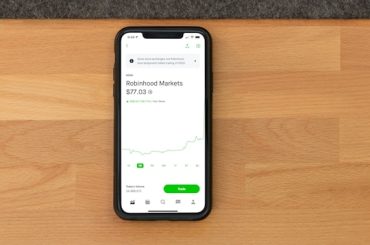
Robinhood SWOT Analysis

Revlon SWOT Analysis

Rebisco SWOT Analysis

Razer SWOT Analysis

Revolut SWOT Analysis

Tencent SWOT Analysis

Telus SWOT Analysis
Type above and press Enter to search. Press Esc to cancel.
Kabinet Tower, Surabaya JIn. Mayjen Yono Soewoyo AK 2 no.27, Surabaya, Indonesia 60256
Domino’s Marketing Strategy : A Full Study Case
- February 6, 2024

Domino’s marketing strategy – Domino’s Pizza , a global leader in the pizza industry, has carved out a prominent position for itself through its effective marketing strategy. With a network of stores in over 85 countries, Domino’s has become a household name, serving millions of customers each week.
In this article, we will delve into the key elements of Domino’s marketing strategy, including its food culture impact, 30-minute promise, brand familiarity, global presence, consistent quality, innovation, promotions, and discounts. By understanding these strategies, we can uncover the secret ingredients that have contributed to Domino’s remarkable success.
Read More : Dior’s Marketing Strategy : A Full Study Case
1. Domino’s Food Culture Impact

Domino’s marketing strategy – Domino’s revolutionized the pizza delivery industry by introducing the concept of carryout pizza delivery. This innovative approach allowed customers to enjoy pizzas in the comfort of their own homes or workplaces, eliminating the need to visit a restaurant.
This convenience and speed attracted more customers, leading to Domino’s exponential growth. Today, the brand serves over 60 million customers weekly and has a strong presence in more than 85 countries worldwide. This global reach has solidified Domino’s customer base and fueled its continued expansion.
2. Domino’s 30-Minute Promise
One of Domino’s most iconic marketing strategies is its 30-minute promise. The company guarantees that pizzas will be delivered to customers’ homes within 30 minutes of placing an order. If the delivery exceeds this timeframe, the customer is rewarded with a free pizza as a token of appreciation for their patience.
This promise not only attracts new customers but also incentivizes repeat business. Franchise locations are required to meet this standard, ensuring fast turnaround times and customer satisfaction. By consistently delivering on this promise, Domino’s has built a reputation for reliable and efficient service.
3. The Brand’s Familiarity
Domino’s marketing strategy – Domino’s has strategically developed its brand reputation and familiarity among customers. The 30-minute delivery promise has played a significant role in establishing Domino’s as a reliable provider of high-quality food and quick service. Many customers rely on Domino’s during busy workdays, knowing they can count on prompt delivery.
Additionally, Domino’s gained popularity through its “30 minutes or free” promotion, which encouraged people to try the brand and spread the word. This widespread familiarity has contributed to Domino’s success and increased its popularity among the general public.
4. Domino’s Global Presence
Domino’s marketing strategy – In addition to its strong presence in the United States, Domino’s has expanded its reach globally, now operating in over 100 countries. This international expansion has allowed Domino’s to tap into new markets and attract a diverse customer base.
By conducting extensive market research and understanding the preferences of target customers, Domino’s has successfully tailored its offerings to meet local tastes and preferences. Expanding into new markets has been instrumental in driving business growth and generating revenue.
5. Consistent Quality and Innovation

Domino’s marketing strategy – Domino’s has positioned itself as a world-class brand by consistently delivering high-quality pizzas. The brand uses only the best ingredients to create its signature pizzas, ensuring a superior taste and dining experience.
Domino’s also embraces innovation by offering a wide variety of pizza choices to cater to different palates. Whether customers prefer classic options or adventurous flavor combinations, Domino’s has something for everyone. This commitment to quality and innovation has solidified Domino’s position as the top choice for pizza lovers.
6. Packaging Quality and Brand Identity
Domino’s marketing strategy – Domino’s physical evidence includes its attractive family outlets and distinctive packaging. The brand’s outlets provide a welcoming environment for customers to enjoy their pizzas.
The packaging features promotional branding and ensures that pizzas are delivered hot and in optimal condition. Employees wear uniforms that reflect Domino’s strong values and commitment to quality.
Customers can make payments through various methods, including cash, cards, and mobile payments. The brand’s customer support is available online or via phone, providing assistance and addressing any concerns.
7. Promotions and Discounts
A key aspect of Domino’s marketing strategy is its frequent promotions and discounts. Domino’s always has some enticing offer running, such as buy one get one free deals or discounts on specific menu items.
These promotions attract customers who are looking for value and affordability. By offering regular discounts, Domino’s successfully differentiates itself from competitors and entices customers to choose their brand over others. This strategy has proven to be effective in driving customer acquisition and retention.
8. Why Domino’s Still Runs Buy One Get One Free Offers?

Domino’s marketing strategy – Despite building a strong brand, Domino’s continues to run buy one get one free (BOGO) offers. These deals have become a cultural tradition in the pizza industry, attracting customers who seek value and savings.
Domino’s leverages these offers to stay competitively engaged and retain its customer base. The key lies in making it easy for customers to take advantage of the deals and presenting them in an attractive and effective manner.
Read More : 8 Disney’s Marketing Strategy: A Case Study
Domino’s marketing strategy has been a recipe for success, propelling the brand to the forefront of the pizza industry. Through its food culture impact, 30-minute promise, brand familiarity, global presence, consistent quality, innovation, and promotions, Domino’s has established itself as a customer favorite.
By continually adapting and innovating, Domino’s ensures its offerings cater to diverse tastes and preferences. As Domino’s continues to expand its reach and delight customers around the world, its marketing strategy remains a key ingredient in its recipe for success.
Gerard Jovian Brand
Related posts.

Gatorade’s Marketing Strategy: How They Dominates the Sports Beverage Industry
- April 12, 2024

8 Proven Marketing Strategies for New Store Openings

11 Gymshark Marketing Strategy : A Comprehensive Analysis
- February 25, 2024
Trending now


Award winner: Domino’s Pizza: Business Continuity Strategy During the Covid-19 Pandemic

This case won the Overall winner category at The Case Centre Awards and Competitions 2023. #CaseAwards2023
Author perspective
Instructor viewpoint, who – the protagonist.
Domino’s Pizza as it adjusted to the COVID-19 pandemic.
Domino’s Pizza is an American multinational pizza giant, popular for its take-out and delivery service across the world.
Domino’s boasts more than 17,000 stores in over 90 countries. As of December 2019, 98% of its stores were franchise-owned.
Domino’s found themselves in an advantageous position due to their prowess in delivery and a new ‘contactless’ delivery initiative.
Other initiatives included Indian customers being able to order their groceries and additional essentials via the Domino’s app, and each of the 6,126 company and franchised-owned US stores donating at least 200 pizzas to people in their communities.
However, Domino’s didn’t escape criticism, as many felt employees were being put at risk at a time when most people were being asked to stay indoors. Furthermore, there were several incidents of employees speaking out at their dissatisfaction of the working environment.
As of March 2020, Domino’s and its franchisees employed around 400,000 people worldwide, reporting same-store sales growth of 1.6% for its US stores and 1.5% in its international stores.
It was 31 March 2020 when Domino’s released the encouraging preliminary sales results for the first quarter ending 22 March 2020.

Domino’s Pizza were well set to push on with their ‘contactless’ delivery approach.
10,000 employees were being hired in US stores while more store workers and delivery drivers had been taken on in the UK and Australia.
With contactless delivery seemingly here to stay post-COVID, is Domino’s in a healthy position going forward?
AUTHOR PERSPECTIVE
This is the first time that ICFAI Business School (IBS) have won the Overall Award.
Debapratim sadly passed away from COVID-19 in May 2021. His comments below were originally published when we featured this case in Connect in November 2020.
Winning the award
Prof. J Mahender Reddy, Distinguished Advisor, ICFAI Society, said: “I am very happy to learn that the late Debapratim Purkayastha (Deb) is the 2023 Overall Award winner.
“Deb is the doyen of case research and teaching. His contributions to making ICFAI Business School - Case Research Center (IBS-CRC) known globally as one of the top case study publishers, will remain forever.
“Deb’s legacy will live on. He will continue to inspire case writers at IBS-CRC and the case research and teaching community across the world.”
Writing the case
Debapratim stated: “We soon realised that the Domino’s case would become ‘the case’ that would be discussed in business schools during the pandemic, and long after the pandemic was over. The challenge was how to capture it in all its richness and complexity and bring it to the online classroom almost in real time.
“These were still early days in the pandemic, and changes were happening almost every day with new information arriving on a daily basis. We ultimately decided to set the time of the case at around mid-April, when Domino’s, as well as other organisations, were uniquely challenged due to the onset of the pandemic, and while there was a lot of uncertainty regarding the future.”

Teaching the case
Debapratim added: “The Domino’s case worked very well in the online mode. Most students were stuck at home due to a government-imposed lockdown, and could easily relate to the issues arising in the case. Many were either missing their pizzas or were grateful that they still had supply – something they have always taken for granted. They could see, how like them, businesses too were affected, and how they were coping, adapting or innovating.
“As we discussed Domino’s business continuity plan and how it could build resilience and come out stronger in the post-crisis period, I felt the students themselves also felt a lot more optimistic about the future.”
Debapratim concluded: “The key takeaway from this case is how Domino’s banked on its core competencies and strategic capabilities to weather the public health crisis with limited disruption to its operations. Not only did it have to adapt its business model, but also balance the need for providing its service to customers as well as keeping its employees and customers safe.
“This case will remain a lesson in how to ensure business continuity amidst a pandemic.”
Instructor VIEWPOINT
Discover how this case works in the classroom.

The authors

Educators can login to view a free educator preview copy of this case and its teaching note.
View all the 2023 winners
Don't miss a thing - join our case community today.
Benefits include: lower prices for teaching materials, a 50% discount on Learning with Cases: An Interactive Study Guide , royalties on case sales, free attendance at the annual Members' Case Forum, discounted case workshop places and much more!

Discover more



Domino's Pizza
Russia Moskovskaya oblast' Gorod Elektrostal'
Prospekt Lenina, 35/20, Elektrostal, Moskovskaya oblast', Russia, 144003
Domino's Pizza Prospekt Lenina, 35/20, Elektrostal, Moskovskaya oblast', Russia, 144003
Location & hours.

QCRV+C5 Elektrostal, Moscow Oblast, Russia
Domino's in states of russia, recommended reviews.

Svetlanskaya St, 18a, Vladivostok, Primorskiy kray, Russia, 690091
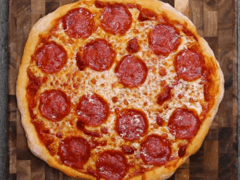
Kroshka-Kitaoshka
Ulitsa Postysheva, 41b, Vladivostok, Primorskiy kray, Russia, 690033

8-Ya Liniya V.o., 23, Sankt-Peterburg, Russia, 199034

Domino`s Pizza
Grazhdanskiy Prospekt, д. 111, Sankt-Peterburg, Russia, 195265

COMMENTS
Domino's Pizza Case Study Analysis: Introduction. Domino's Pizza is a fast food chain of restaurants that is headquartered in the United States of America, but it has a large network of international branches worldwide (Abc News, 2013, para 5). The firm was established in 1960 by two brothers, Tom Monaghan and James Doyle, following the duo ...
How Domino's Pizza Reinvented Itself. I spent the last 18 months researching and writing a book on how organizations and leaders can do extraordinary things, even if they operate in pretty ...
A. Atacan Garip. In this paper, Company Information, Corporate Governance, Internal-External Environment, Strategic Factor's Analysis and Strategy Formulation for Domino's Pizza are available. Read more. Business. 1 of 15. Download Now. Download to read offline. Strategic Case Analysis of Domino's Pizza - Download as a PDF or view online for free.
Before we dive deep into the PESTEL analysis, let's get the business overview of Domino's. Domino's Pizza, Inc. is an American multinational pizza restaurant chain founded in 1960. The company is headquartered in Ann Arbor, Michigan, USA, and operates in over 90 countries worldwide. Domino's is known for its focus on delivery and ...
He pursued a multi-pronged strategy mainly relying on digital transformation: Domino's got rid of their 49 years old recipe. Now they included delicious garlic, buttery crust, and added a category "Specialty Pizza" consisting of lightly breaded chicken topped with cheese and exotic toppings such as bacon and jalapeno.
Per Figure 5, Domino's grew its share of the global QSR market from 1.1% in 2012 to 1.6% in 2019. A strong business model positioned the company to benefit when other businesses were retreating ...
A Case Study of Domino's Pizza's Crisis Communication Strategies. Abstract. Domino's Pizza was embroiled in a viral crisis situation when two rogue employees posted videos of adulterated food on YouTube in April 2009. Tim McIntyre, Vice President of Communications, was part of the internal team that delivered the company's crisis ...
Domino's is a mainstay of the global food delivery industry thanks to its delectable pizzas and lightning-fast delivery. With a core customer base predominantly from the US, followed by India and Malaysia, Domino's 2021 revenue reached 4.36 billion USD.. Behind the brand's phenomenal success is a well-thought-out marketing strategy that has set the company apart from its top competitors (Papa ...
AFP via Getty Images. In conventional terms, Domino's Pizza is a winner. Its CEO, Rich Allison, was on CNBC's Mad Money yesterday, touting Domino's strong post-pandemic financial performance ...
Domino's Pizza is an American multinational pizza giant, popular for its take-out and delivery service across the world. Domino's boasts more than 17,000 stores in over 90 countries. As of December 2019, 98% of its stores were franchise-owned.
Here is the SWOT analysis for Domino's. A SWOT analysis is a strategic planning tool used to evaluate the Strengths, Weaknesses, Opportunities, and Threats of a business, project, or individual. It involves identifying the internal and external factors that can affect a venture's success or failure and analyzing them to develop a strategic ...
Analysis: Pizza Hut has the highest CPM result followed by Domino's at 2. Papa John's is the least among 3 competing brands. Over $1 billion in long term debt severely impacts Domino's stockholders' equity and financial profit.
Increased market share: Domino's overtook Pizza Hut as the largest pizza delivery company globally in 2018, with a market share of 18.6% (Statista, 2021). Conclusion:
4. Domino's Global Presence. Domino's marketing strategy - In addition to its strong presence in the United States, Domino's has expanded its reach globally, now operating in over 100 countries. This international expansion has allowed Domino's to tap into new markets and attract a diverse customer base. By conducting extensive market ...
Also, we analyze the last 10 years of company's market response to curb the effect of slowdown in sale, due to bad quality, service and rising competition in 2007-2010. The way strategic ...
Dominos-Pizza Draft - A case study on Domino's Pizza for Strategic Management in one of the case works. Strategic Management 96% (71) 2. Soda-Case-3 - Soda Case. Strategic Management for 3rd Year BS in Accountancy students. Strategic Management 100% (1) 8. Chapter 03 - Lecture notes 03.
Domino's Pizza as it adjusted to the COVID-19 pandemic. What? Domino's Pizza is an American multinational pizza giant, popular for its take-out and delivery service across the world. Domino's boasts more than 17,000 stores in over 90 countries. As of December 2019, 98% of its stores were franchise-owned. Why?
Domino's is the largest pizza company in the world based on global retail sales, with a well-established presence both in the U.S. and internationally. Founded in 1960, Domino's has grown into a ...
The leader in this market happens to be Domino's. Domino's currently has over three times the number of stores that Papa John's has domestically and internationally. Domino's is one of the oldest pizzas chains the United States being in business for over 60 years. Pizza Hut, another major competitor, has been in business for even longer than ...
Welcome to the 628DirtRooster website where you can find video links to Randy McCaffrey's (AKA DirtRooster) YouTube videos, community support and other resources for the Hobby Beekeepers and the official 628DirtRooster online store where you can find 628DirtRooster hats and shirts, local Mississippi honey and whole lot more!
Elektrostal is a city in Moscow Oblast, Russia, located 58 kilometers east of Moscow. Elektrostal has about 158,000 residents. Mapcarta, the open map.
President of Domino's Pizza, recorded an apology that was then uploaded onto YouTube. During this event, bloggers and journalists alike captured this crisis in articles and case studies, offering step-by-step timelines1 (Jacques, 2009; Peeples & Vaughn, 2010) and criticisms of Domino's responses (Beaubien,
A study from Yale says that Moscow is waging a successful disinformation war when it comes to its economic figures. The study showed that the crippling sanctions and international boycott had undermined Russia's status as an exporter of goods to the point of its near-collapse, and imports had fallen by almost 50%.
Prospekt Lenina, 35/20, Elektrostal, Moskovskaya oblast', Russia, 144003. Dominos near me contact number is +7 495 900-01-72.